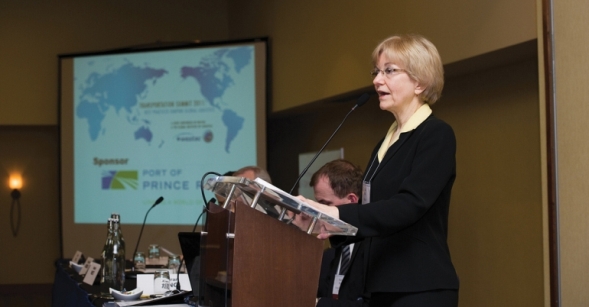VANCOUVER MAY 2011
TRANSPORTATION SUMMIT 2011 BEST PRACTICES SHAPING GLOBAL LOGISTICS
Melissa Edwards Canadian Sailings
Mr. Ring is CEO of the Global Institute of Logistics (GIL), a U.S.-based not-for-profit supply chain research group, which partnered with Canada’s Western Transportation Advisory Council (WESTAC) to hold the conference in Vancouver. “If you are a well-paid soloist, being asked to join an orchestra is a big move,” Mr. Ring said. “Everyone in their silo is doing a great job. But the value gets trapped in the handover.” Mr. Ring said point-to-point thinking and a system built on an old-fashioned “legacy” model has resulted in 8.9 cents out of every dollar being spent on logistics in the U.S. In China, where the cost is as high as 20 cents, a new five-year plan is in place to get the cost below the U.S. figure.

RUTH SOL PRESIDENT WESTAC : “The Global Institute of Logistics just blew us away. They had so much information,
“When resources are limited, let’s not reinvent things. We can find a better way with the best of what others already know.”
“We can get our cost down by half if we remove the silos,” Mr. Ring said. He told the crowd that the only question left in the move toward orchestration is: Who will act as bandleader? Mr. Ring’s organization is in the final stages of a four-year research project on best practices in global logistics.
WESTAC president Ruth Sol told Canadian Sailings that the idea for the summit arose after her team met with GIL in October. “They just blew us away. They had so much information,” she said. “When resources are limited, let’s not reinvent things. We can find a better way with the best of what others already know.”
GIL began its research process by forming global committees for each silo (shippers, logistics professionals, port authorities, terminals, shipping lines, information technicians, warehouses, distributors and customers), as well as regional cross-silo chapters with links to government, academics and service providers. Mr. Ring said GIL set out with the idea that terminal operators might be well placed to take a leadership role in a collaborative system, so it undertook a three-year study of terminal hubs such as Yantian in China.
The research culminated in the creation of GIL’s Container Terminal Quality Indicator (CTQI) trademark. GIL examined factors such as gross moves per hour, equipment age, truck calls, throughput and other metrics, and created benchmark figures against which terminal quality can be improved. Those who meet the benchmarks can earn CTQI status.
Mr. Ring hopes that GIL can expand this benchmarking process to other parts of the supply chain. “Everyone who touches (the container) should have a quality indicator,” he said. While the benchmarking process made the research worthwhile, the lack of transparency inside the gates of the terminal meant the operators were not “the white knights” GIL had set out to find, Mr. Ring said. “But then we found the port authority. The new generation (of port authority) is moving beyond being landlords to become economic strategists. They’re not competing, because the collective performance of their stakeholders leads to better performance for the port.
ABOUT WESTAC
The Western Transportation Advisory Council (WESTAC) is a non-profit association dedicated to advancing Western Canada’s economy through excellence in transportation. Founded in 1973 by four western provincial transport ministers, the Council is a well-respected, powerful and balanced forum of major organizations. Member organizations span the modes and sectors and include service providers, labour unions, shippers, policy-makers and regulators.
WESTAC’s vision is to be the prime catalyst for supply chain excellence. The Council promotes transportation as a critical sector supporting trade, jobs and our high standard of living, and advances solutions to transportation problems across sectors. As one of Canada’s premier transportation organizations and a trusted industry champion, WESTAC ensures that transportation retains its vital status in the community.
WESTAC Homepage
